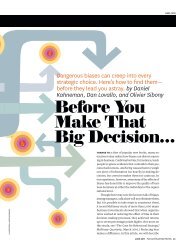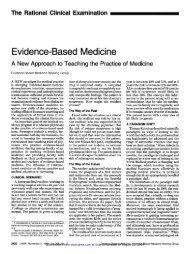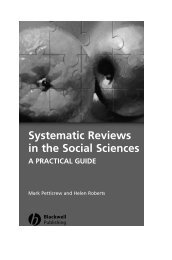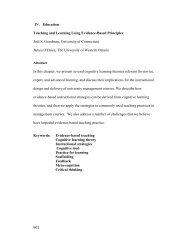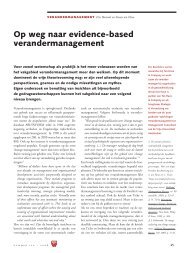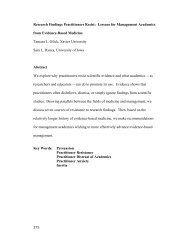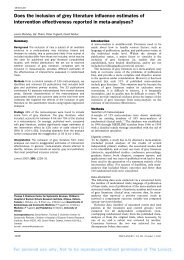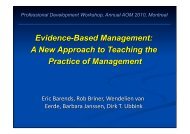Reflections of Teaching Evidence-Based Management - Center for ...
Reflections of Teaching Evidence-Based Management - Center for ...
Reflections of Teaching Evidence-Based Management - Center for ...
Create successful ePaper yourself
Turn your PDF publications into a flip-book with our unique Google optimized e-Paper software.
than we otherwise are when we make decisions or act without aids. Askingstudents to describe all the in<strong>for</strong>mation and decision aids they use in their lives(from shopping lists to goals on posted notes) introduces the broad utility <strong>of</strong>in<strong>for</strong>mation and decision aids. This sets the stage <strong>for</strong> subsequent discussions <strong>of</strong>how scientific findings can be organized into procedures, checklists, and otherartifacts that eases their practical use (e.g., Yates & Potwoworski, this volume).EBMgt instructors may also wish to consider presenting ideas like theattitude <strong>of</strong> wisdom (Pfeffer & Sutton, 2007) and the set <strong>of</strong> steps to becoming anevidence-based manager (Rousseau & Barends, 2011) as part <strong>of</strong> creating basicawareness. Together those sources encourage managers to think about decisionsexplicitly, ask <strong>for</strong> and seek out evidence, and use the best available knowledge.Note that the best available knowledge at a given point in time may be incompleteand is prone to obsolescence. Thus, evidence-based managers must be open tolearn and adapt management practices in light <strong>of</strong> better evidence (Pfeffer &Sutton, 2007). Revisiting explicitly the four facets <strong>of</strong> EBMgt outlined byRousseau (this volume) is another way to rein<strong>for</strong>ce the dynamic nature <strong>of</strong> EBMgt– it is a decision-making process in which evidence from <strong>for</strong>mal research isconsidered in conjunction with evidence from the local context, stakeholderperspectives and preferences, and practitioner judgment and expertise. Thisoverview material can be presented as a stand-alone, in a brief workshop atorientation or a lunch discussion, to get students thinking about EBMgt’s fourfacets. Consider having students ask questions about a management problem byusing each EBMgt element as a perspective to consider.1012



